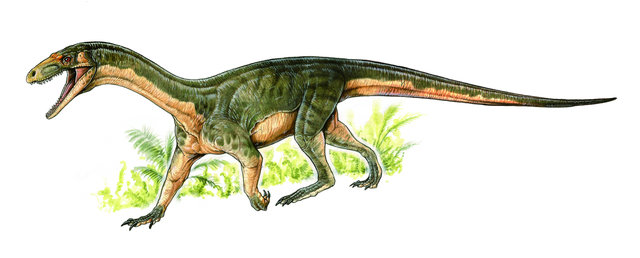 |
| Life reconstruction of the new species Teleocrater rhadinus, a close relative of dinosaurs. |
Now, a decade after Charig’s death, the animal behind these puzzling fossils has been identified as Teleocrater rhadinus, a scrappy reptile that is forcing a rethink of early dinosaur evolution. Importantly, it reveals that animals looked like dinosaurs even before actual dinosaurs existed.
T. rhadinus uniquely possesses crocodile, non-avian dinosaur, and bird features, according to a paper describing the species that appears in the journal Nature. Charig is listed as the paper’s senior author, honoring his earlier work on the fossils.
Lead author Sterling Nesbitt of Virginia Tech’s Department of Geosciences and his team obtained more remains for the reptile in 2015 and subsequently analyzed all of the fossils. The researchers determined that the toothy predator marched around on four limbs like a crocodile and had croc-ish ankle joints.
In terms of classic dinosaur characteristics, it possessed a long neck, a Tyrannosaurus rex-like hunger for meat, depressions for an enlarged jaw musculature on the roof of its skull, and muscular upper legs like those of many non-avian dinosaurs and later birds.
The fossils suggest that Teleocrater grew to about 6.5 to 10 feet long and weighed between 20 and 65 pounds. Nesbitt and his team suspect that it feasted on many different types of animals, including close relatives of mammals.
 |
| Teleocrater rhadinus hunting a cynodont, a close relative of mammals. |
Teleocrater was dated to 245 million years ago, close to the time when early reptiles known as archosaurs diverged into two major lineages: one that led to crocodylians (aquatic reptiles like alligators and crocodiles) and another that, through dinosaurs, eventually led to today’s birds. Teleocrater is now the oldest known member of the latter group.
Given this important positioning, Teleocrater is sure to be used as a model animal for understanding dinosaur origins. Previously, Triassic reptiles like Lagerpeton and Marasuchus were in this role, but Teleocrater is even older.
“Teleocrater was part of a side branch of dinosaur cousin,” Nesbitt said. “It never became a dinosaur, just like a chimp will never become a human.”
As a result, the species has no direct living descendants today. Nevertheless, it possessed both iconic crocodile and dinosaur characteristics some 10 million years before the first unambiguous dinosaurs evolved in what are now Argentina, Brazil, Zimbabwe, and India.
“Teleocrater and its close relatives show that the overall body plan that once was thought to characterize crocodile-line reptiles was also present in the first members of the lineage that led to dinosaurs,” co-author Martin Ezcurra of the Museo Argentino de Ciencias Naturales in Buenos Aires said in a statement.
Teleocrater and its relatives, which form a group called Aphanosauria per the new paper, were very widespread. Their remains have been found not only in what is now Africa but also in Russia, India, and Brazil.
Nesbitt said that the Triassic Period has long been considered to be the great “Age of Crocodile Relatives” because these aquatic reptiles were diverse, abundant, and located across much of the planet during that time. Now it’s known that Teleocrater and other close relatives of dinosaurs were equally diverse and widespread during the same time, setting the stage for dinosaurs dominating the Jurassic Period.
Read more at Discovery News
No comments:
Post a Comment